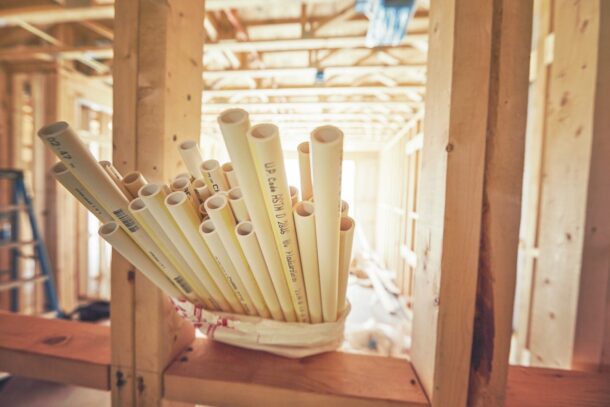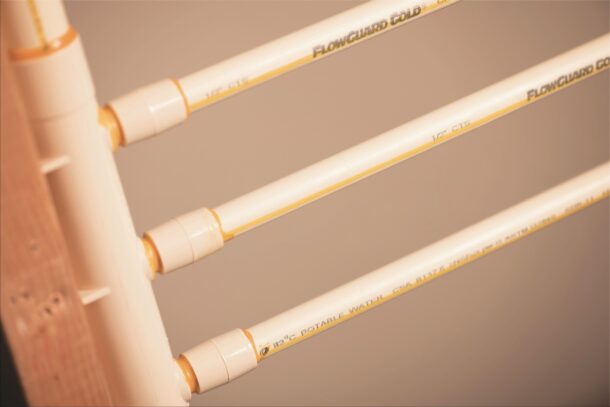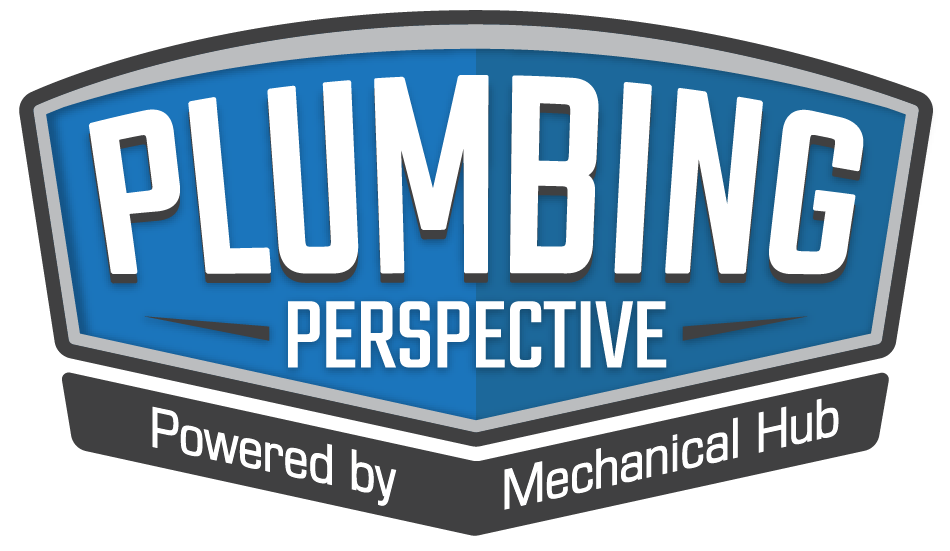By Jonathan Simon Most homeowners don’t think about the plumbing materials in their homes until a problem occurs. Yet, plumbing materials play a significant role in their day-to-day quality of life, especially when the system doesn’t deliver on their expectations. Some plumbing systems can contribute to issues like poor water pressure and water quality. Then Read more
Jonathan Simon

By Jonathan Simon
Most homeowners don’t think about the plumbing materials in their homes until a problem occurs. Yet, plumbing materials play a significant role in their day-to-day quality of life, especially when the system doesn’t deliver on their expectations.
Some plumbing systems can contribute to issues like poor water pressure and water quality. Then, of course, there are the reliability problems that can arise when the plumbing system proves incompatible with local water conditions, leading to failures and water damage that can turn a homeowner’s life upside down.
So, while homeowners don’t spend much time thinking about plumbing materials, plumbers should. Here are four ways that you can protect your customers thanks to the performance of CPVC.

Water Pressure
Low water pressure can be frustrating for homeowners every time they shower, and the design of the plumbing system could be a contributing factor.
Plumbing systems using insert fittings where the fitting goes into the pipe will reduce the system’s diameter at the fitting, restricting flow and creating a much larger pressure loss than occurs with systems where the pipe is inserted into the fitting, such as CPVC and copper. Even expansion fittings, which have the largest internal diameter of the insert fittings, can cause up to 7x more pressure loss in the system compared to a CPVC or copper fitting.
Insert fittings can also create turbulent zones in the pipe as water jets out of the restriction created by the fitting. These higher-velocity zones may require that the design velocity of the system be reduced to remain within manufacturer specifications.
Plumbers can compensate for the issues created by insert fittings by upsizing piping, but that adds significant cost to projects. Using larger pipe to slow down the water and reduce pressure drop can also pose challenges in areas that need to comply with water and energy efficiency standards. By minimizing pressure drop across the system, CPVC helps preserve water pressure at fixtures.
Water Quality
No plumbing system can improve water quality, but the choice of materials can minimize the risk of various sources of contamination.
One of those risks is biofilm growth. Biofilm that forms inside residential plumbing systems can contain bacteria such as E. coli, coliforms and legionella. The susceptibility of a particular material to biofilm is called its biofilm formation potential and varies across materials. Independent research has found that CPVC has a lower biofilm formation potential than other plastic plumbing systems and is consistently among the lowest of plumbing systems tested.
Permeation and leaching also present risks to residential water systems. Materials vulnerable to permeation can allow dangerous chemicals that come in contact with the outside of the pipe to enter the water supply. The U.S. EPA, in their study on Permeation and Leaching, found that vinyls such as CPVC are virtually impermeable at low levels of exposure and that polyolefin plastic plumbing materials accounted for more than three-quarters of the documented permeation incidents in the United States.
NSF 61 is the industry standard for protecting against unsafe leaching of chemicals from plumbing materials into the water supply. FlowGuard Gold CPVC is certified to NSF 61 under all water conditions. Copper and some PEX brands have limitations on their NSF 61 listings.
By reducing the risks from biofilm formation, permeation and leaching, plumbers play an important and underappreciated role in protecting the health of their customers. And while homeowners may never fully appreciate that role, they could notice the difference in water quality when materials other than CPVC are used. According to research from Virginia Tech, CPVC has the lowest impact on drinking water taste and odor of any residential plumbing material.
Reliability
In addition to good pressure and water quality, homeowners want a plumbing system they don’t have to worry about. If there’s one thing more frustrating than a water leak, it’s having a second leak soon after the damage from the first has been repaired. That was the experience of the Jackson family in Battle Ground, Washington. They had multiple plumbing system failures, one after the other, until an expert finally diagnosed the root cause of the problem as incompatibility between the plumbing material chosen for their ten-year-old home and local water conditions. When the home was repiped with CPVC, the problems disappeared.
CPVC is the only residential plumbing material that is naturally immune to chlorinated drinking water. As municipalities strive to maintain water safety through treatment methods that produce higher oxidative reduction potential in the water they supply, this is more important than ever. CPVC can perform reliably in water conditions and at temperatures, pressures and velocities that could lead to degradation and early failure in other plastic or metal plumbing systems.
Sustainability
For homeowners that prioritize the sustainability of building materials, CPVC is a very attractive choice. Based on comparisons using the National Institute of Standards (NIST) BEES software, FlowGuard Gold CPVC requires less energy to manufacture, has lower embodied energy and results in fewer emissions over its service life than PEX and copper. CPVC is also recyclable through proper centers.
In addition, FlowGuard Gold CPVC is the only residential plumbing system certified by Home Innovation Labs National Green Building Standard (NGBS) and has a lifecycle assessment to enable the material to contribute to LEED certification.
Making the Right Choice
If you’re looking to give your customers the water quality, pressure, reliability and sustainability they are looking for, CPVC is the right choice. And CPVC doesn’t just deliver benefits to homeowners. Plumbers experience lower material costs, faster installation and excellent support from leading manufacturers. To learn more, visit flowguardgold.com/plumber-resources.
Jonathan Simon is the North American residential plumbing manager for Lubrizol Advanced Materials. Half of the world’s consumers use at least one product containing a Lubrizol ingredient. Advanced materials products create and/or improve the performance of our customers’ products and enable unique performance attributes. For 60 years, FlowGuard Gold Pipe and Fittings have provided reliable hot and cold water plumbing systems to residential and commercial buildings.

By Jonathan Simon In plumbing, like many trades, knowledge is often shared plumber-to-plumber in the field. That allows experience to get passed from one generation to the next. But sometimes the information shared doesn’t keep up with new developments or, like a childhood game of “telephone,” gets distorted over time and becomes inaccurate. The result Read more
By Jonathan Simon
In plumbing, like many trades, knowledge is often shared plumber-to-plumber in the field. That allows experience to get passed from one generation to the next. But sometimes the information shared doesn’t keep up with new developments or, like a childhood game of “telephone,” gets distorted over time and becomes inaccurate. The result is the proliferation of “myths” that are accepted as true by some but are provably false. Here are five myths related to CPVC plumbing systems that the FlowGuard Gold® CPVC team has encountered in the field–and the truth behind the myth.
Myth 1: CPVC should be replaced when it shows signs of discoloration
It’s easy to see how some myths get started. A plumber may think that discoloration is an indication of structural weakness, decides the pipe needs to be replaced and passes that “tip” onto a younger plumber.
But older CPVC pipes that show signs of discoloration do not need to be replaced. CPVC naturally becomes more rigid as it ages and may discolor, but these factors do not increase the risk of failure in a properly installed and serviced system. In fact, the pressure-bearing capability of CPVC pipes improves with age, so, by that measure, an older CPVC pipe is actually stronger than it was when first installed.
It is recommended that plumbers use C-style cutters, a wheel cutter, or a fine-tooth saw when servicing older CPVC pipes, but there is no reason to remove the pipe from service due to discoloration. One of CPVC’s strengths is the material’s long service life—some of the first CPVC pipes ever installed back in the 1960s are still in service today–and discoloration is not a reason to shorten that service life.

Myth 2: CPVC is difficult or slow to install
Some myths are rooted in misperceptions and false assumptions while others can be traced to competitors seeking to gain traction in a competitive market. The myth that CPVC is difficult to install falls into the second category.
CPVC plumbing systems are similar to copper in their design. Both are rigid systems that use socket-style fittings in which the pipe fits into the fitting. But CPVC is easier to work with than copper and the solvent welding process used to bond CPVC pipes and fittings is simple, easy to learn and does not require any special tools. CPVC plumbing systems install faster than copper and have installation times that compare favorably to PEX systems.
Independent research studies that measured installation times for CPVC and PEX systems found that CPVC trunk-and-branch systems install up to 17% faster than comparable PEX trunk-and-branch systems. A PEX mini-manifold system installed 10% faster than a CPVC trunk-and-branch system but used 21% more pipe and the added material costs outweighed the time savings. Most plumbers with experience using both materials have reported no noticeable speed difference between CPVC and PEX plumbing systems.
Myth 3: CPVC can’t handle higher pressures and temperatures
A review of material specifications will quickly dispel this myth. Plumbing codes require that domestic water plumbing systems be capable of handling at least 100 psi of pressure at 180°F without ballooning or bursting. FlowGuard Gold pipes and fittings not only meet this requirement but are pressure rated to 400 psi at room temperature and above 200 psi at all temperatures up to 140°F. When subjected to extreme quick-burst testing, a solvent-welded FlowGuard Gold CPVC plumbing system will not typically fail until the system reaches pressures of 1200 psi or higher.
In addition, CPVC isn’t subject to additional temperature and pressure limitations imposed by chlorinated water on other plastic plumbing systems (140° F and 80 psi). That makes CPVC ideal for higher temperature applications such as hot water lines. It can even support legionella mitigation strategies that store water above 140°F. In multi-story buildings, CPVC’s excellent pressure rating enables use of gravity-fed distribution systems and booster pumps that can introduce risks to other plastic plumbing systems.
Myth 4 CPVC is not as sustainable as other plumbing systems
You might expect a plastic piping system like CPVC to be less sustainable than a metal system like copper, but CPVC has excellent sustainability credentials.
FlowGuard Gold CPVC requires less energy to manufacture and produces fewer greenhouse gases over its service life than PEX and copper systems. The material’s long service life, enabled by its chlorine immunity, means less material is ultimately required to support the application. Plus, CPVC is recyclable through proper centers.
FlowGuard Gold CPVC is also the only residential plumbing system certified by Home Innovation Labs National Green Building Standard (NGBS) and has a lifecycle assessment to contribute to LEED certification.
Myth 5: CPVC is more expensive than other plastic plumbing systems
Plumbers who haven’t compared material costs can be forgiven for believing CPVC is one of the more expensive plumbing systems. After all, FlowGuard Gold CPVC is the only material in the industry that offers a warranty that isn’t voided by exposure to chlorinated water, putting it in a class by itself. It doesn’t make sense that it should be less expensive, but it is. According to a cost study done by a leading PEX manufacturer, CPVC material costs were half the cost of their own PEX system.
These savings come from two key areas: fittings and pipe sizing. While a PEX system contains about 30% fewer fittings than a CPVC system, those fittings (and the crimp, cinch or expansion rings that go with them) typically cost 3-5 times more than the comparable CPVC fitting. In addition, because those insert fittings introduce significant pressure drop at ½” diameters, PEX systems are typically upsized to use more 1” and ¾” pipe than required with a CPVC system, saving even more money. You can verify this yourself by comparing PEX and CPVC costs on your next job.
Better Information Leads to Better Service
Plumbers looking to deliver the best service to their customers and grow their business should be careful not to take everything they hear at face value. There are resources available that provide reliable information about plumbing systems, including manufacturer websites. To get more information on CPVC, visit the plumber’s resource center on the FlowGuard Gold website.
